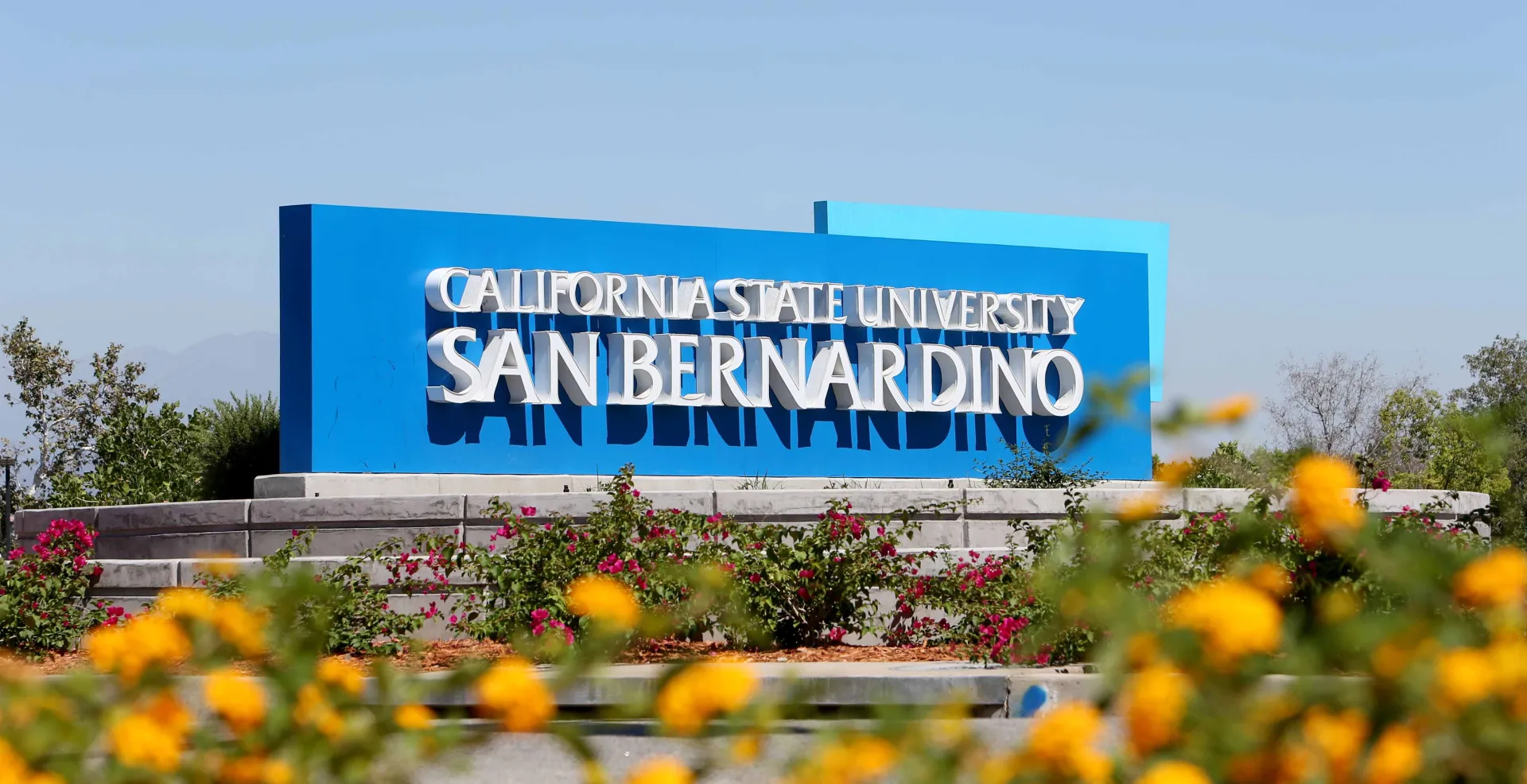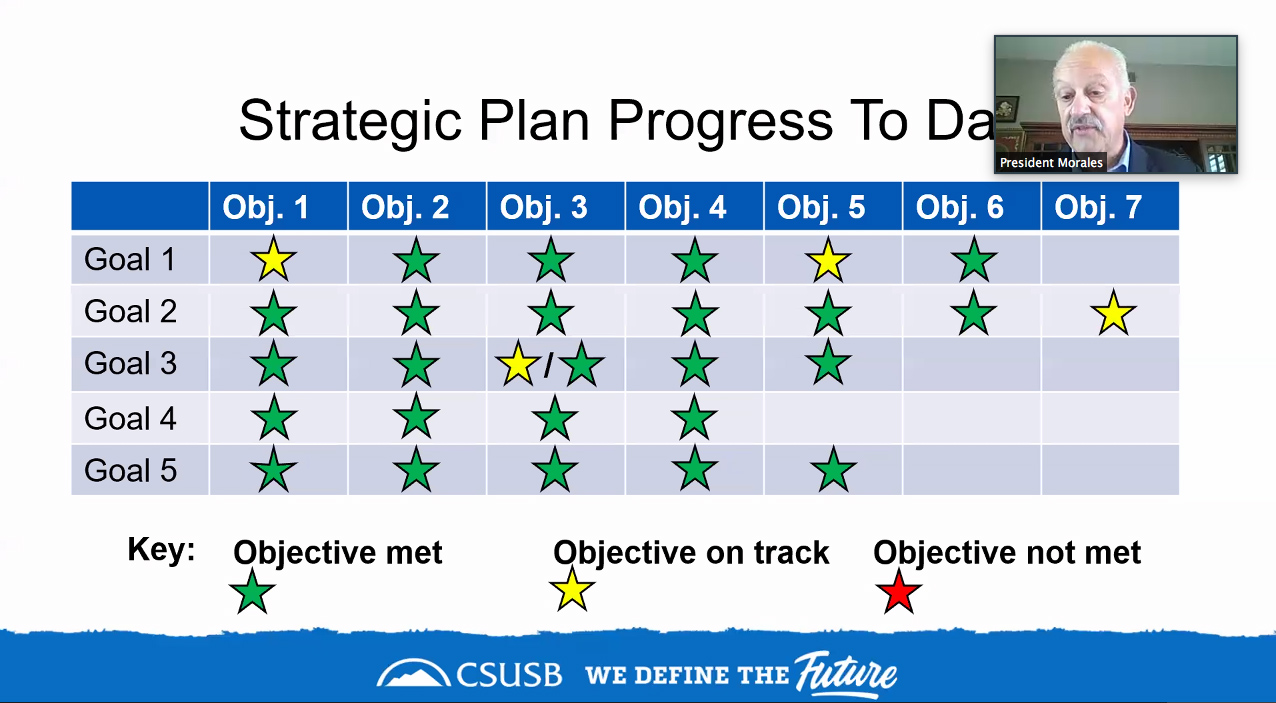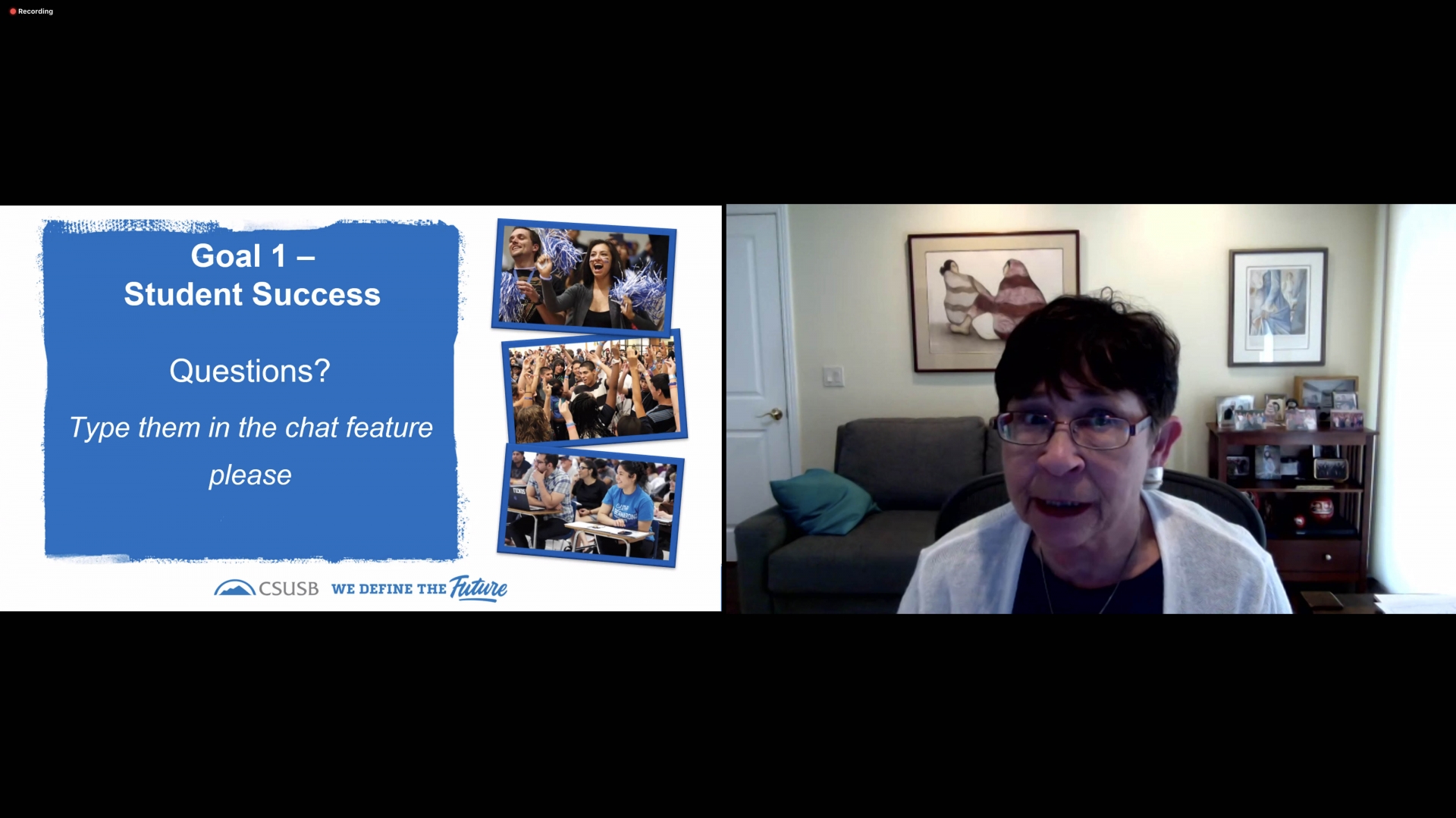Joe Gutierrez | CSUSB Office of Strategic Communication | (909) 537-5007 | joeg@csusb.edu

More than 200 faculty, staff and students attended an online town hall meeting on April 20 to discuss Cal State San Bernardino’s strategic plan, the blueprint that serves to define the university, its mission and its future.
The meeting was transitioned to a virtual format to safeguard the health and safety of the attendees in the wake of the COVID-19 pandemic.
University President Tomás Morales, who welcomed the attendees, said the current CSUSB Strategic Plan, enacted at the start of the 2015-16 academic year, has led to an extensive and detailed collaborative effort that involved the entire university, which included the review and clarification of the university’s mission, vision and values.
“From that effort the strategic plan was finalized, establishing a focused list of five strategic goals and corresponding objectives to help achieve those goals,” Morales said. “The result was a roadmap that we have followed, implementing the plan and, at the end of each year, measuring and assessing our progress.”
The goals and progress to date are:
- Goal 1 – Student Success – met four of six established objectives and on track with the other two;
- Goal 2 – Faculty and Staff Success – met six of the seven objectives and on track with the remaining one;
- Goal 3 – Resource Sustainability and Expansion – met four of the five objectives and on track with the remaining one;
- Goal 4 – Community Engagement and Partnerships – met all four objectives; and
- Goal 5 – Identity – met all five objectives.

As originally conceived, the strategic plan would conclude at the end of the academic year in June and typically efforts would have begun up to 18 months prior with another collaborative process to prepare the next multi-year plan, Morales said.
But because of a number of factors – quarter to semester transition, WASC reaccreditation, and implementation of the CSU Graduation Initiative 2025 – that process was not initiated, Morales said.
Earlier this year, a series of discussions took place involving governing and advisory groups that included the CSUSB Faculty Senate, Associated Students Inc., the CSUSB Regional Strategic Plan Advisory Committee and Mark Goor, chair of the WASC Accreditation Team. Those discussions led to a shared conclusion that the best available option was to extend the current strategic plan and expand it to cover two additional years, Morales said.
That was the purpose of Monday’s strategic plan town hall meeting, the president said – to review what still remains to be accomplished of the existing goals and objectives of the current plan as well as any additional goals suggested during discussions, and a list of proposed objectives that support successful completion of the new goals.
“We want your input regarding these objectives and to hear your thoughts on how we should proceed during the two additional years of the strategic plan,” Morales said.

Jolene Koester, who serves as a consultant to the university, facilitated the town hall and summarized how the meeting would work.
She had each of the strategic plan’s five goals discussed individually. One of the university’s five vice presidents then introduced and discussed possible additional objectives that could be added by vote to that particular goal, which were followed by a question-and-answer period where the attendees posed their own questions.
At the conclusion of the question-and-answer period, the attendees were directed to a special website to vote on the top two or three objectives for each goal.
Those recommendations will then be forwarded to the president and cabinet for discussion and consideration.
The suggested additional objectives by vote were:
- Increase access to course offerings and flexibility of courses, based on demand: face-to-face and online and increase online training for students: ITS (ATI) will work with Academic Affairs, the TRC and the faculty community in designing and delivering high-quality online courses in order to expand our students’ access to courses.
- Advising – career, financial literacy, ITS Amazon-like experience: The goal of this objective is to improve students’ experience when they use the ITS systems to conduct business and removing all administrative barriers from their academic experience. From helping students add courses to their registration process based on their academic plan, to registration, to paying fees to adding/dropping classes, the goal is to make student experiences as seamless, just as it is when they are on Amazon.com. ITS will collaborate with Undergraduate Studies and Student Affairs to remove administrative barriers and create processes for all administrative functions that are AI-driven and mobile-compatible.
- More cohesive and robust Basic Needs Initiative: Develop a comprehensive, cohesive Basic Needs Initiative to ensure students’ physical, mental, and financial health and well-being.
Goal 2 – Faculty & Staff Success
- Diversity and inclusion strategic plan: Develop a diversity and inclusion strategic plan for CSUSB through the assessment of diversity recruitment, development, and programmatic efforts.
- Coordinated support for faculty development: Create a coordinated support structure for faculty development. Evaluate faculty development efforts in terms of professional and leadership support for our untenured/tenured faculty from recruitment to retirement relative to student success, as well as identify targeted support for lecturers.
- Staff mentoring network: Create a staff mentoring network to enhance the onboarding experience for new employees, as well as assisting continuing staff with their professional development aspirations.
Goal 3 – Resource Sustainability & Expansion
- Environment sustainability – renewable energy and value-based: Annually adopt at least two annual new strategies to further reduce the carbon footprint of CSUSB, including but not limited to, reduction of greenhouse gas reliance, enhanced regional transportation connections supporting CSUSB campuses, joining nationally recognized sustainability commitment network for higher education, food and disposables waste reduction. Develop LEED (or equivalent) certification strategies for all new major capital construction.
- Space management: Develop a comprehensive plan to identify and assess utilization of existing space on campus, along with assessing specific needs for space to support university growth and expansion.
- Continue to increase philanthropic support and assess feasibility of second comprehensive campaign: Enhance the university’s fundraising productivity by 25 percent by 2023 by establishing a culture of philanthropy where donor support is honored and reflected in effective stewardship. By 2023, the CSUSB Philanthropic Foundation will become one of the premier philanthropic boards in the Inland Empire and increase the endowment portfolio from $49 million to a minimum of $60 million by 2023. Complete by fall of 2020, proposed campaign assessment by interviewing 40 of the university’s major donors to determine readiness and goal for the university’s next comprehensive campaign.
Goal 4 – Community Engagement & Partnerships
- Continue to work with school districts and community colleges to improve college readiness: Continue to strengthen K-12 to college pipeline for students in the region through new and existing partnerships with school districts and community colleges.
- Strengthen community presence and relationships: Solidify and strengthen CSUSB’s role as an anchor institution through cultivating partnerships and continuing efforts to build strategic relationships with families, community organizations, tribal nations, and regional schools and community colleges to build community capacity and educate a highly diverse workforce. Build strong relationships with Inland Empire elected officials and their staff, at all levels of government, through regular communications, one-on-one meetings and campus visits, utilizing the advocacy of alumni and third-party organizations.
Goal 5 – Identity
- Universalize assessment and continuous improvement using Campus Labs: Under the leadership of the Offices of Strategic Technology Initiatives and Institutional Research and Analytics and in coordination with the Council for Assessment and Continuous Improvement, grow the university identity as a learning institution through a focus on a culture of evidence and continuous improvement. Provide transparency into strategic planning for internal reporting needs and continuous improvement cycles, collect and synthesize information/data for external reporting needs, and engage with campus stakeholders (faculty, staff, students) to develop active collaboration and foster shared meaning using sound principles of change management.
- Expand alumni mentoring program: Expand current alumni mentoring program to engage alumni and support students with completing their academic goal.
- Branding consistency: Ensure a process is developed across the entire university that consistently and constantly requires all external and internal communications materials present an appropriate image and consistent style as expressed in the branding standard manual for all written and graphic communications.
At the meeting’s conclusion, President Morales thanked the participants for their efforts.
He said that the strategic plan’s “existing goals and objectives that have not yet been fully achieved will continue to be funded. Additionally, new funding will be established to successfully achieve the new goals and established objectives.”
Morales added that all the proposed objectives discussed during the town hall will be reviewed. Any that are not included within the extended strategic plan will be passed along to the appropriate colleges and divisions so they may be acted upon within their respective strategic efforts.